MicroGrid Tour
A Continuous Power Loop
Like a necklace displaying many jewels, the MicroGrid encircles Stone Edge Farm with a wide variety of interconnected electrical devices.
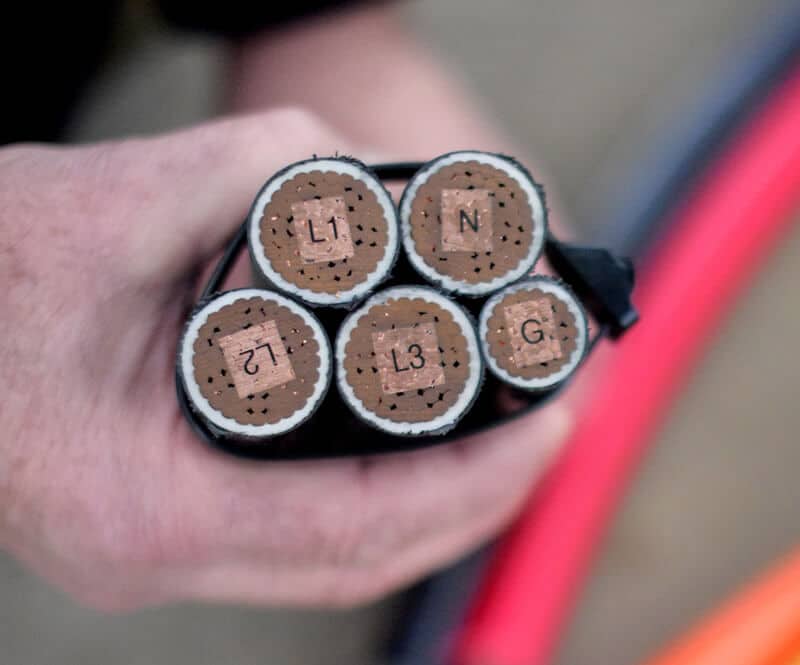 Trunk line cross-section shows a neutral (N) and
three power lines (L1,2,3), one inch in diameter
(quarter-sized), plus a dime-sized ground (G).
Trunk line cross-section shows a neutral (N) and
three power lines (L1,2,3), one inch in diameter
(quarter-sized), plus a dime-sized ground (G).
The MicroGrid unites seven electrical service entrances – four 240-volt, single phase (240V/1P) alternating current residential connections and three 480-volt, three phase (480V/3P) services -- on five previously separate parcels that now constitute the farm. It connects distributed energy resources (DERs) that produce power (solar panels, microturbine, fuel cells) and store power (batteries, hydrogen) for use by loads (irrigation pumps, buildings, electrolyzer).
The trunk line is a continuous loop of copper cables weighing 12 pounds per foot. It is 480V/3P with ground, and bi-directional with no single point of failure, so power generated anywhere on the MicroGrid can be used anywhere else. The trunk line connects four nodes plus the DER plant/H2 park (see below).
Stone Edge Farm comprises 25 buildings on 16 acres. Currently in place are 12 solar arrays on ten buildings with 553 photovoltaic panels and a capacity of 160 kW. Three major battery types, or chemistries, and nine different inverters installed at 11 sites, three fuel cell hives, and a microturbine bring total power capability to over 600 kW.
Modes Of Operation
Like other microgrids, ours operates connected to and importing electricity from the utility grid – in grid-tied normal mode. The Automatic Transfer Switches (ATSs) at all service entrances are in the “normal” closed position.
In grid-tied parallel mode, six of the seven ATSs are in the open or emergency position, leaving a single point of common coupling (PCC) with the utility grid at Wyatt Road in the DER plant. At this one 480V connection between trunk line and grid, the entire system can be easily monitored and both import and export of power are possible.
In island mode, all ATSs are in open/emergency position, totally disconnecting the farm from the utility grid, and the loads of all 25 buildings are powered by the trunk line, entirely fed by locally sourced power.
Communications & Critical Grid
The MicroGrid’s Communications loop runs underground parallel to the trunk line. The Critical Grid is a back-up system of lower voltage, solar-charged “buffer” batteries that provide an uninterruptible power supply (UPS) to protect essential equipment.
In emergencies, when electrical harmonics and distortions could disrupt the MicroGrid, the Critical Grid ensures continuous operation of important devices like computer servers, Ethernet and fiber optics switches, alarm systems, emergency lighting, and electrically operated gates.
What Is A Node?
The four nodes on the MicroGrid are convenient switching points where two or more electrical services exist in close proximity, and supply and demand can match up. Switches join these circuits and enable power to flow wherever it is needed on the property.
Each node has management (Communications and Control) and backup power (Critical Grid) systems.
Node One
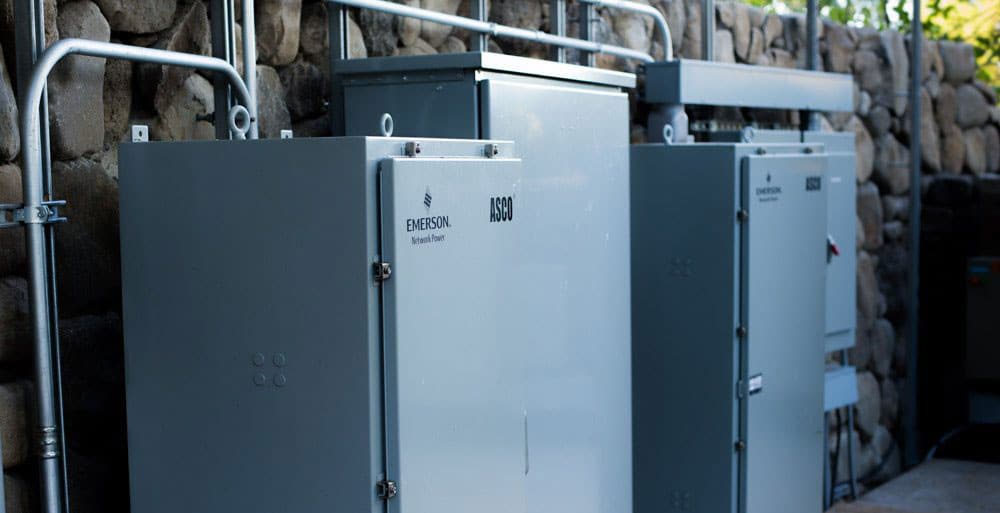 Emerson ASCO ATSs
Emerson ASCO ATSs
Located near the garage in the southwestern corner of the farm, Node 1 connects three of the property’s seven electrical services, two of them 480V/3P 200 amps (200A) and one 240V/1P 400A. Despite considerable shade, a 20-panel solar array contributes power at a rate of 5kW.
Three Emerson ASCO 7000 series automatic transfer switches (ATSs) are “gatekeepers” that can automatically or manually connect the MicroGrid to or disconnect it from the utility grid.
A natural gas/hydrogen-fired 65kW Capstone microturbine, basically a stationary jet engine, provides backup power within three minutes. This triple redundancy asset can function in a master role during island mode. Because it performs more efficiently at high rpms and is designed for long-term operation, its use is prioritized behind solar arrays, batteries, and fuel cells.
Exhaust heat from the microturbine is captured for a hydronic (liquid heat and cold transfer) plant capable of heating four buildings and two swimming pools. This is a tri-generation or combined cooling, heating, power (CCHP) plant. Read more
On top of the microturbine, a heat exchanger raises its efficiency to over 90% by using exhaust to heat two 500-gallon water tanks that provide radiant heating. A 10-ton Yazaki lithium bromide absorption chiller converts hot water to chilled for summer cooling.
Instead of using a conventional cooling tower, which can evaporate 1,000 gallons of water per day, the heat exchanger has a closed pipe loop to circulate water through existing wells, cooling it with ground water.
Nearby, seven 3.4kW SimpliPhi Power lithium ferro phosphate batteries, connected in a 23.8kW/45kWh stack with a 280V/3P SMA Sunny Island System inverter, protect Critical Grid functions at the Zen spa and observatory.
The garage roof has 20 solar panels producing 5kW, while the Zen spa array totals 68 panels that generate 19kW.
Node Two
 Aquion Energy battery
Aquion Energy battery
Set between the shop and the Butler building on the farm’s southwestern side, this node joins two 480V/3P circuits.
Here, an Eaton computerized panel provides power management with breakers operated by the control system. This panel can manually or automatically shed non-critical loads instantly and in order of priority for three minutes while the microturbine fires up to provide backup power.
The Aquion Energy sodium ion battery consists of a string of eight 48V M-Line battery modules connected in series and combined by a 30kW Ideal Power AC/DC power conversion system into one 384V string. The 16KW/100kWh battery’s electrolyte is essentially seawater.
In the Butler building are Critical Grid servers, backed up by a stack of eight Sony lithium iron phosphate batteries with a combined rate and capacity of 2.4kW/9.6kWh, paired with a 6kW 120V Outback inverter. On the roof, 36 solar panels generate 9kW.
Node Three
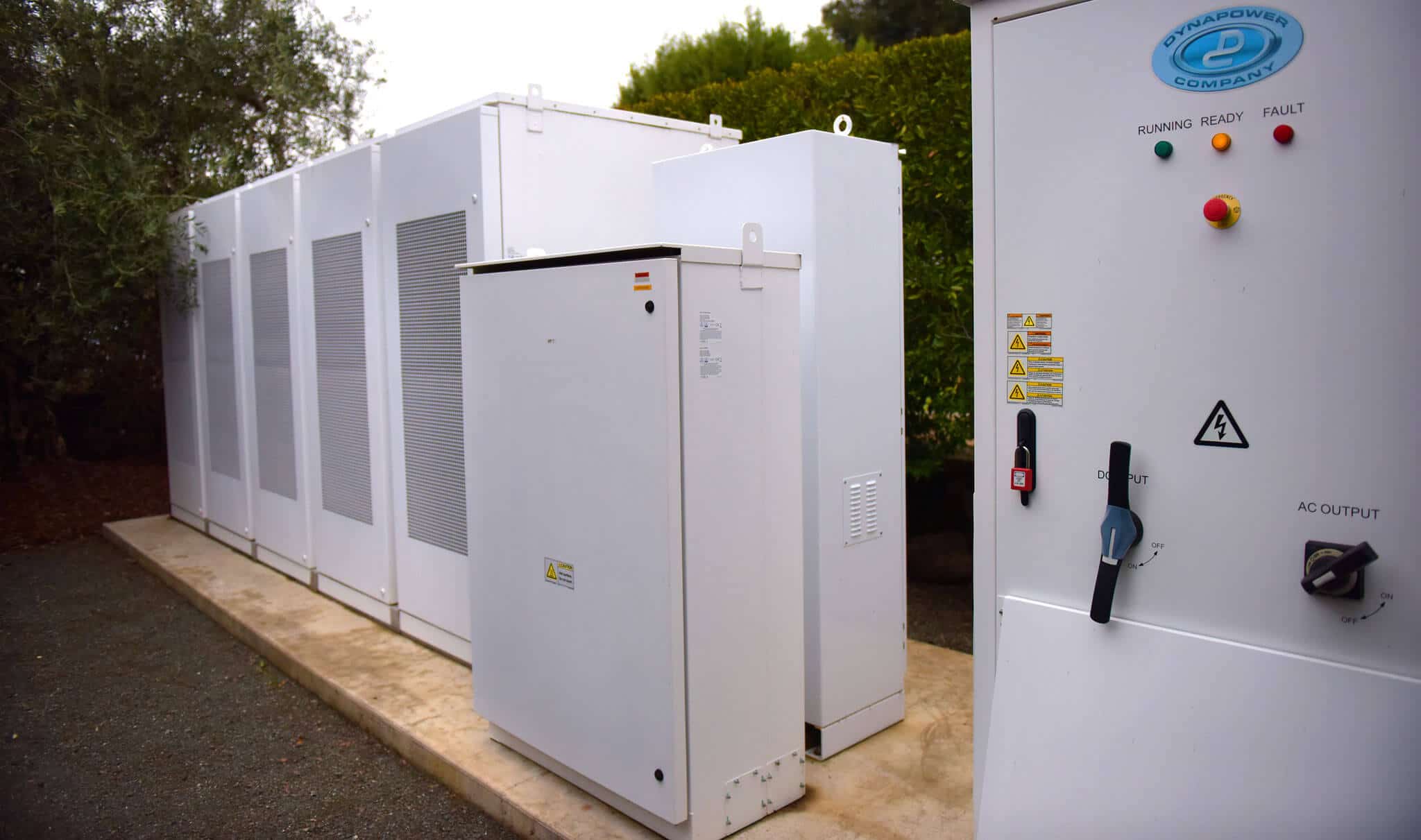
Tesla Powerpack cabinets
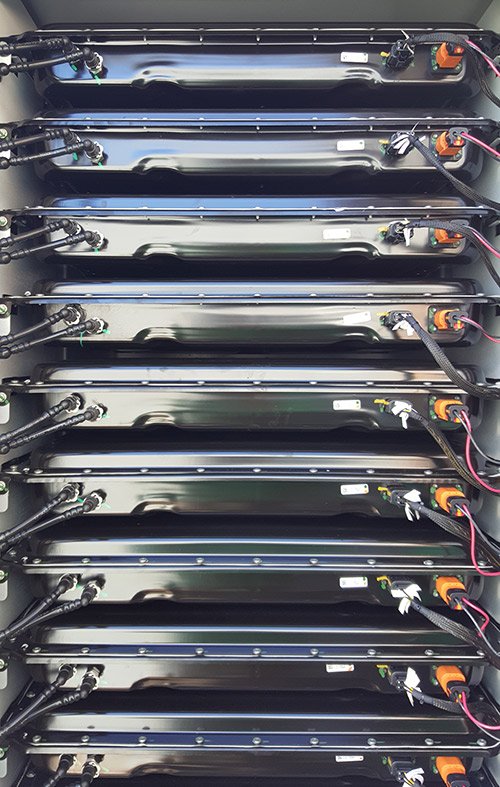
Tesla Powerpack stack
This node has switching for 240V/1P 400A services to each of three houses – called Guest, Glide, and Gate – on the eastern side of the farm. The 61 solar panels on these homes together contribute 16 kW, while the auto barn/office arrays have 189 panels, and the dining barn/auto barn-2 arrays a combined 56, for a total of 306 panels and 98kW.
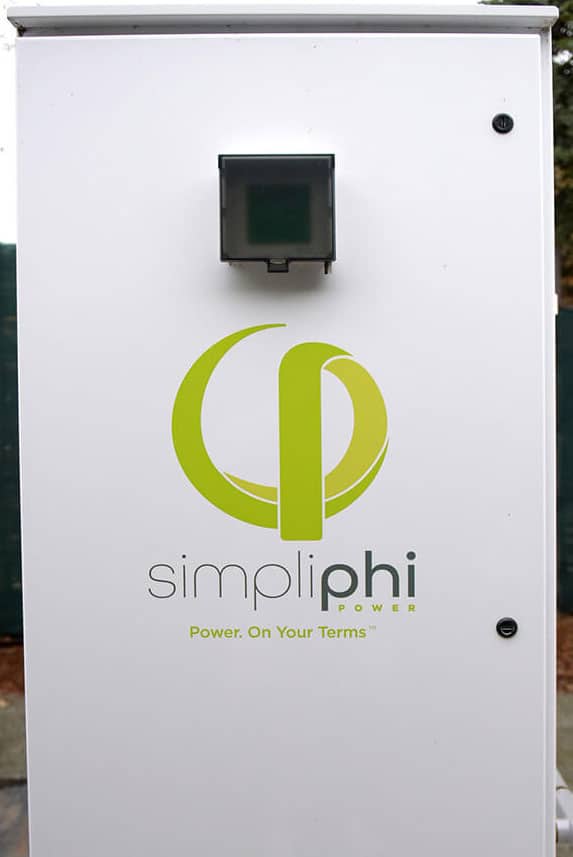 Simpliphi AccEss
battery
Simpliphi AccEss
battery
Close by are five stacks of 16 trays each inside white cabinets, the same Tesla lithium ion batteries that power the manufacturer’s cars. This Powerpack, with its 250kW/475kWh rate and capacity, delivers substantial power in a short amount of time through a 250kW Dynapower inverter. When the MicroGrid operates in island mode, the Tesla battery can generate its own 60-Hertz cycles, serving in a master, or grid-forming, role.
Maintaining the Critical Grid here is a stack of three 3.5kWh 48V SimpliPhi AccESS lithium ferro phosphate batteries that produce 5.7kW/10.5kWh output and capacity with a 6.8kWh Schneider inverter with charge controller.
A 10kWh 240V LG Chem RESU lithium ion battery with a 9.8kW Solaredge SE 7600A inverter provides additional backup, delivering considerable power quickly for short periods of time to accommodate peak loads.
Node Four

Near the chicken coop at the farm’s north end is a 480V/3P junction where power flows from a solar-panel rich environment to the tree-shaded but power-demanding south. With real-time monitoring, motorized mechanical breakers here can be remotely controlled to divert power to consumption areas or shut down high voltage in case of fire or other emergency.
DER Plant
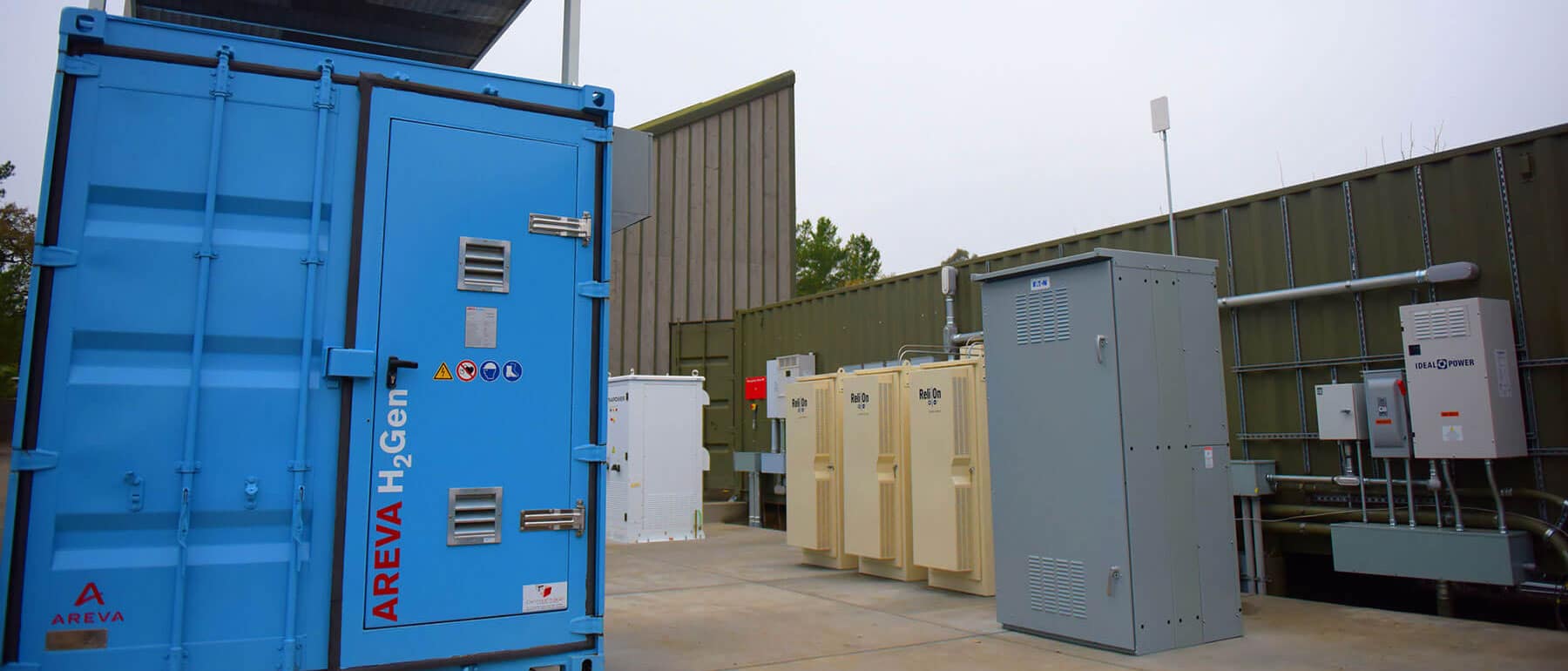
On a spur of land in the farm’s northwest corner, the distributed energy resource (DER) power plant can be electrically isolated for special study purposes.
The single point of common coupling (PCC) with the utility grid is where we monitor our entire system as one entity, measuring each of multiple assets running, and where electricity can be imported or exported.
The ATS here, a specially developed Emerson ASCO Microgrid Actuation Circuit, appropriately called the “MAC switch,” measures power quality. If voltage and frequency are normal on the utility grid, that connection is maintained. If not, the switch looks for voltage and frequency on the emergency (MicroGrid) side and, finding it, first synchronizes them before switching to island mode. This switch can either be controlled or operated automatically
Located here as well are California Independent Service Operator (CA ISO) and Pacific Gas & Electric (PG&E) service meters, and a Schweitzer relay, an extremely fast safety device that protects people working on the grid. The ag shed roof holds a 123-panel solar array that generates 29kW.
The new 120kW/26kWh, 480V SimpliPhi Power high-voltage lithium ferro phosphate battery being installed comprises eight cabinets each containing a rack of ten high-voltage 3.6kWh 24V battery modules wired in series with a second rack to form a string of 20. Each string is matched with a Battery Management System (BMS). In island mode, this battery can also function as a master, using the same 250kW Dynapower inverter as the Tesla Powerpack. This multi-master status provides redundancy and resilience with no single point of failure in island mode.
Hydrogen Park
 PlugPower ReliOn fuel cell hives
PlugPower ReliOn fuel cell hives
The hydrogen park includes fuel cell hives, a hydrogen storage and fueling station, and a major installation in progress, an electrolyzer.
The park is a system “round trip,” a complete cycle of electricity starting with surplus solar panel generation that powers the electrolyzer that produces hydrogen gas stored for eventual use in fuel cells that provide electricity for the trunk line or electric cars.
About H2
- Most plentiful element
- Lightest element: 1 proton, 1 electron
- Rises in the atmosphere at 45 mph
- Use has zero environmental impact
- Fuel cell process byproduct is water
- Safer than gasoline, diesel, natural gas
- NASA uses as an energy carrier
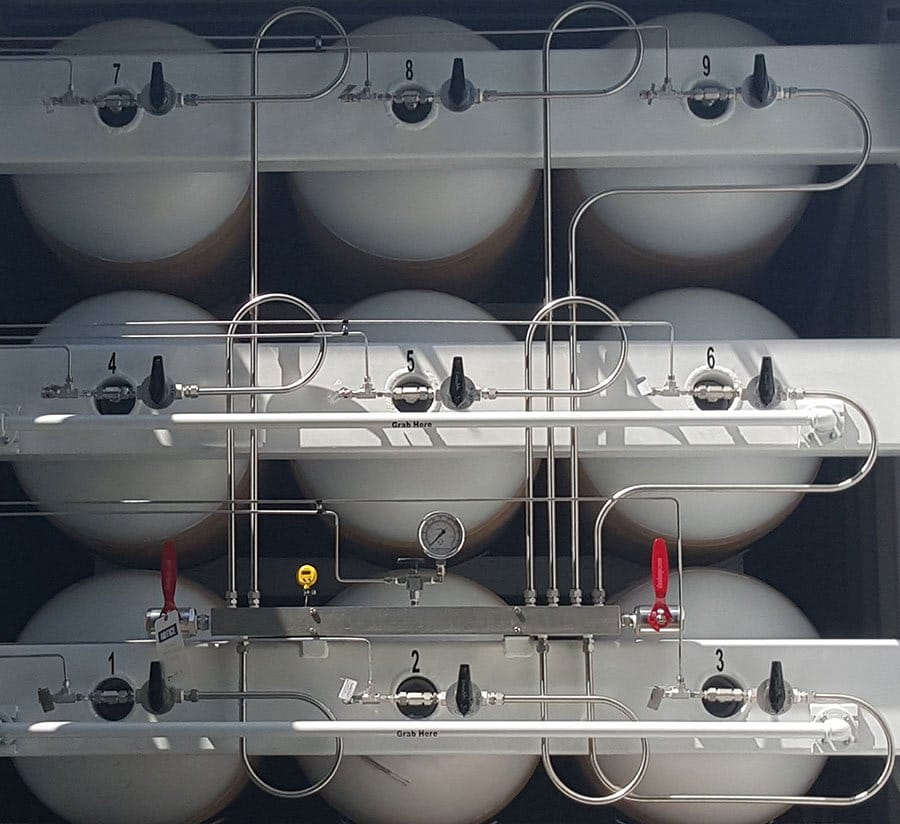 Bulk H₂ transfer module
Bulk H₂ transfer module
The Areva H2 Gen/Giner Electrolyzer container holds three Giner ELX Proton Exchange Membrane (PEM) stacks with the balance of plant – including wiring, electronics, water filtration/demineralization, and hydrogen dryer -- provided by Areva.
After batteries are fully charged, this load uses surplus solar-generated electricity to split water into two non-greenhouse gases, oxygen and hydrogen. The latter can be stored indefinitely without degrading and accessed immediately to power fuel cells. This electrolyzer is “spoolable.” Its output adjusts to match the level of overproduction from solar arrays.
Hydrogen run through the PlugPower ReliOn fuel cell hives reverses the electrolysis process to create electricity on demand. The three hive cabinets each contain a stack of four 2.33kW units, totaling 28kW. If a unit fails, it is easily replaced. The fuel cells feed a 30KW Siemens Sinamics DC/DC converter that boosts voltage for an Ideal Power 30kW inverter, which sends 480VAC/3P to the trunk line.
The farm’s base load at night without irrigation running is 15kW. Our largest (20hp) water pump can consume up to 30kW of power, but it is equipped with a variable frequency drive (VFD) and can spool up and down.
Six smaller pumps, all run along with the largest one, theoretically could spike power use at 50kW, but their use is staggered, and three of them have VFDs. An electrical vehicle (EV) charging station also can consume 30kW. We calculate our maximum load at about 100 kW.
Our system follows the base load at night. If something turns on, the hive activates more fuel cells. SimpliPhi 3.5kW lithium ferro phosphate batteries “buffer,” or provide voltage support, for the cells.
Hydrogen is stored at 6,500 and 10,000 psi in 48 1kg tanks, and at 800 psi in bulk storage on a gas transfer module that holds 200 kg. Our goal is to store 500 kg to serve as a buffer during winter.
Hydrogen also powers our fuel cell-equipped vehicles, Toyota Mirai and Honda Clarity cars. A Millennium Reign Energy fueling station fills their tanks in a few minutes. In both fuel cell applications, hives and cars, the byproduct is pure water with zero carbon emissions.
 Toyota Mirai at the Millennium Reign Energy fueling station
Toyota Mirai at the Millennium Reign Energy fueling station
Control System
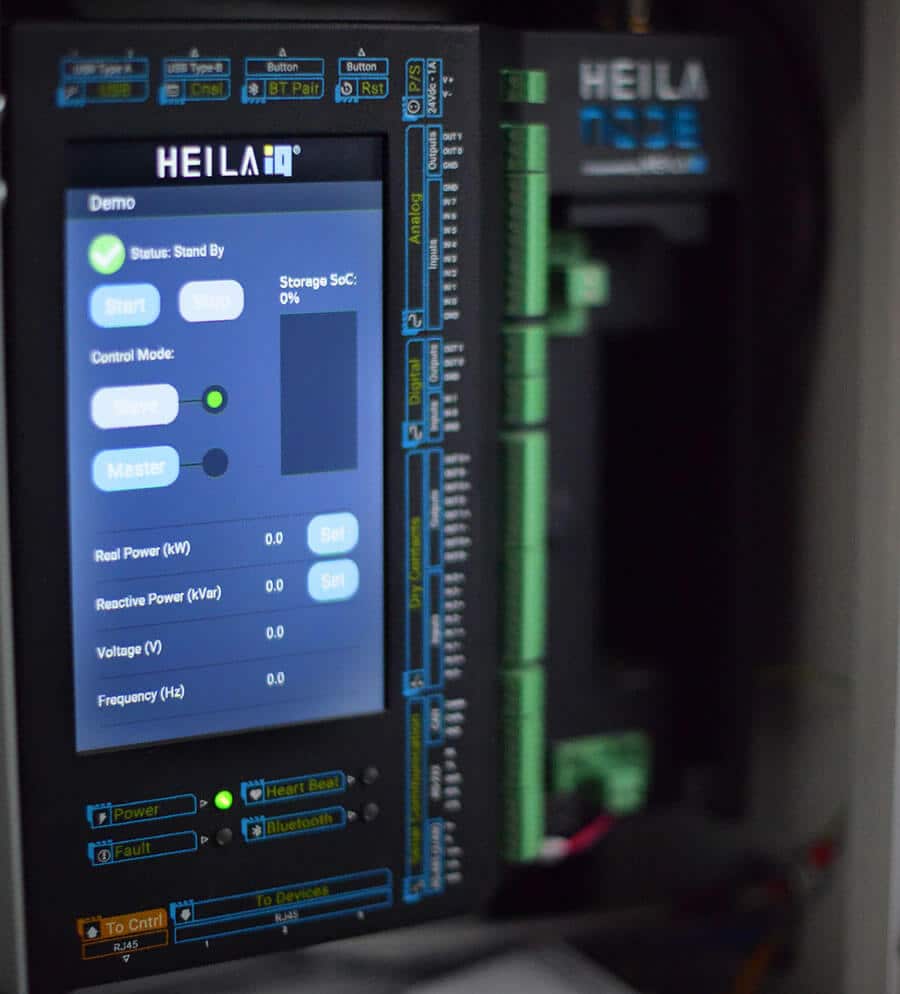 Heila IQ Controller
Heila IQ Controller
“Of all the innovations in the development of the MicroGrid, the most crucial is Jorge Elizondo’s Heila (HAY luh) controller,” according to Mac McQuown.
Each of the different electrical generation, storage, and consumption assets that make up our MicroGrid has its own Heila IQ device. Together, these local controllers form a network with a central coordinator interface that monitors the system, collects, stores, and shares information, and makes very rapid decisions.
Other microgrids often try to simplify control by using a single vendor and one software language. By comparison, the MicroGrid is a United Nations, with numerous diverse assets using different languages and protocols with varying loads, peak usages, and recommendations.
The Heila Technologies IQ Controller and Optimizer, with proprietary software and hardware largely devised on-site, not only translates disparate communications from many devices into a common language, it also conducts an internal dynamic market to fine-tune the MicroGrid. Mac McQuown likens the process to “conducting 20-plus musicians who can’t read music.”
At each independent asset, Heila interfaces -- sampling in real time at ten times per second -- gather and share data, then work collectively and seamlessly using analytics and algorithms to solve problems.
Objective
The control system’s overall objective when islanded is to make judgments and send commands that balance generation, storage, and usage in order to reach and maintain equilibrium, known as optimization mode.
The decentralized control system empowers assets to make their own decisions yet work together, reacting to priorities. In essence, the assets “play” with each other using game theory to achieve the best outcome, all within seconds. Read more
Given a specific goal, Heila uses a variation of blockchain to determine the most efficient/economical power source to use at a given point in time, prioritizing factors such as response time, state of charge, capacity, and carbon emissions.
The MicroGrid is unique in that it doesn’t matter how many or few assets there are; they can be added or removed and the control system adjusts automatically. All decisions are pure supply and demand because all assets are “owned” by the MicroGrid.
Controllable Assets
 Jorge Elizondo with Heila controller on the microturbine.
Photo by Tim Carl
Jorge Elizondo with Heila controller on the microturbine.
Photo by Tim Carl
Controllable assets are those responsive to control signals, ranging from simple to complex, such as on/off, charge/discharge, and spooling up (adjusting speed or output incrementally), from dimmable lighting to variable speed pumping.
Controlled assets are important in balancing small power systems because load variability is more extreme than on utility-scale grids.
On the MicroGrid, parts of six solar arrays, 11 batteries/inverters, four water pumps, three fuel cell hives, a microturbine, and an electrolyzer, as well as some HVAC units, are controllable.
Despite intense smoke and ash from the 2017 wildfires, solar arrays had to be curtailed when supply exceeded demand. Now a portion of output can be controlled much like adjusting volume on a radio.
While most solar array micro-inverters feed straight into the trunk line, eight of the 86 panels at the Zen spa chain together in a DC string to a Fronius inverter with set points of variable discharge, offering a point of control for modulation of solar production. The Butler building has a similar configuration with eight of its 32 panels.
In the auto barn and office arrays, Enphase Energy S280 “smart” micro-inverters enable some output to be curtailed based on frequency.
Both the dining barn and auto barn-2 arrays have Solarmark panels connected in series and land on their own 33kW SMA Tripower string inverter that outputs 480V/3P and is completely controllable by the Heila system.
Grid-tied vs. Islanded
In grid-connected mode, frequency, voltage, and power are balanced by the utility. In island mode, one of our two co-master battery inverters keeps the dynamic load satisfied. Inverters regulate harmonics, but fluctuations in voltage and power must also be minimized.
Voltage is affected by the distance from a battery, for example, and it drops at night and increases with the addition of power.
To keep all loads efficiently supplied with power in island mode, the central controller deploys all assets and dispatches them a “pricing” schedule. Assets respond or not based on power they can provide at what “price,” while factoring in variables like carbon impact and responsiveness as well as cost. In effect, assets “bid” to determine the most economical power source for system equilibrium.
Utility Use
Use of utility grid power depends entirely on the MicroGrid’s monthly operational objectives. Because we periodically install new equipment for testing, we sometimes turn our system off and power loads with the grid. Otherwise, the MicroGrid can island indefinitely.